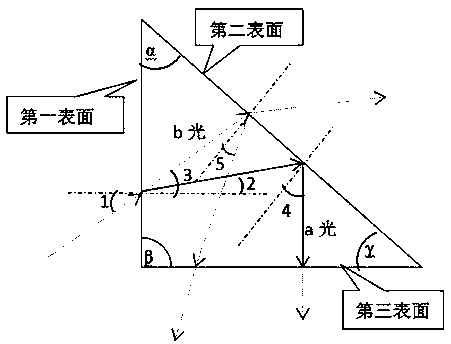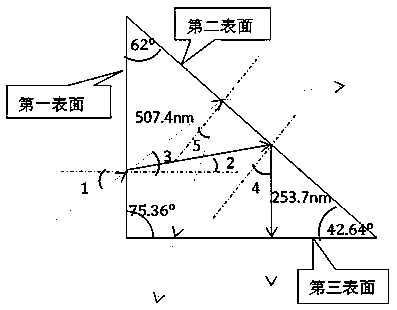A method for setting a prism for separating mixed-wavelength laser light
A technology of mixing wavelengths and setting methods, applied in prisms, optics, optical components, etc., can solve problems such as non-target light interference, and achieve the effect of reducing interference
- Summary
- Abstract
- Description
- Claims
- Application Information
AI Technical Summary
Problems solved by technology
Method used
Image
Examples
Embodiment 1
[0057]In a device for detecting trace mercury concentration based on fiber-coupled laser frequency doubling technology, in order to obtain a laser with a wavelength of 253.7nm near the absorption peak of mercury, two lasers with a wavelength of 507.4nm are emitted through the application of fiber-optic coupling technology. After entering the BBO crystal, the outgoing light will contain laser light with a wavelength of 507.4nm and a laser light with a wavelength of 253.7nm, and the laser light with a wavelength of 253.7nm will be used to detect trace amounts of mercury. This technology avoids the need for ultraviolet lasers and greatly reduces technical difficulty and equipment costs. However, in order to reduce the impact of 507.4nm lasers, it is necessary to separate light of different wavelengths. Through the application of the present invention, it can be very good solve this problem.
[0058] Such as figure 2 As shown, the light containing two wavelengths emitted from th...
Embodiment 2
[0088] In the measurement of mercury content, ultraviolet light can also be obtained by sum frequency technology. When the sum-frequency technique is used to obtain a laser with a wavelength of 253.7nm, the wavelength of the two beams of light incident on the BBO , The relationship should be satisfied:
[0089]
[0090] In this example, the Blu-ray and red light. The light emitted from the BBO therefore includes light of three wavelengths. In order to separate the ultraviolet light, the light emitted from the BBO is injected into the dispersion system of the present invention. The prism is made of quartz glass, and the relationship between the refractive index and wavelength of light of different wavelengths in the medium follows Cauchy's law:
[0091]
[0092] λ is the wavelength of the incident light, and a, b, and c are constants related to the prism material. For a prism made of quartz glass, a=1.443, b=4238, c=10.92, then the refractive indices of light o...
PUM
 Login to View More
Login to View More Abstract
Description
Claims
Application Information
 Login to View More
Login to View More - R&D Engineer
- R&D Manager
- IP Professional
- Industry Leading Data Capabilities
- Powerful AI technology
- Patent DNA Extraction
Browse by: Latest US Patents, China's latest patents, Technical Efficacy Thesaurus, Application Domain, Technology Topic, Popular Technical Reports.
© 2024 PatSnap. All rights reserved.Legal|Privacy policy|Modern Slavery Act Transparency Statement|Sitemap|About US| Contact US: help@patsnap.com










